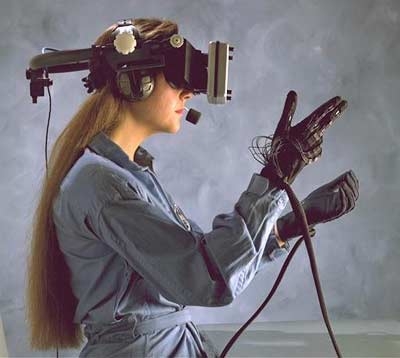
Putting the “Science” into “Science Fiction” – Virtual Reality
Virtual reality is a common fact of life in many works of science-fiction, allowing people to enter into a computer-generated world and interact with it as if the virtual world was just as authentic as the real one. The simulated worlds these virtual reality (or VR) systems create are often shown as being indistinguishable from the real one by those who are interacting with them, including authentic simulations that trick all the senses into believing what they are experiencing is real. The ultimate example of this is in The Matrix trilogy, where the majority of the human race is connected to a communal VR system that is so real that simulated death in the virtual world kills the person in the real world. In order to access one of these virtual worlds, people in science-fiction must often directly interface with the computer that produces it, whether through the massive implants used in The Matrix or small headphone-like wires such as those used in many other science-fiction stories. In either case, these types of virtual reality work by interfacing directly with the user’s brain, inputting signals that cause the brain to ignore sensory stimulus from the real world in favour of that created by the computer. In this way, the virtual world replaces the real one in the user’s mind while allowing him to interact with it in a way that feels completely real and natural, as the mental signals that would usually cause their body to move are received by the computer and used to create changes in the virtual world. Unfortunately, systems like this require the surgical implantation of a jack for the wires to connect to, and interacting with such a convincing virtual reality could cause unforeseen negative side-effects.
Although the perfection of mind-machine interfaces in the future may allow this type of virtual reality to be created, modern systems are far less advanced. The current generation of virtual reality systems usually consist of a visor or set of goggles and some type of input device, such as a handheld remote or joystick. The headset has a pair of built-in screens that project a video of the virtual world, totally immersing the user while also blocking out external sights that would distract them from the experience. In a similar manner, speakers built into the headset play sounds to help the user feel even more immersed in the experience. The headset also contains a system to track the movement of the user’s head, and this information allows the screens to change to match the switch in orientation. This creates the illusion that the wearer is standing in a real three-dimensional space, and is the core aspect of the virtual reality experience. Although the headset is very exotic, the control device is usually fairly mundane, consisting of a controller or joystick like those used in video game systems. These controllers may also have a motion sensor built into them and in these cases this is linked to the visor’s view, allowing the user to see the motions of the controller and interact with the virtual world in a realistic way. When controllers are used in this way, they are usually disguised as a sword, gun or other object in the user’s vision in order to avoid breaking immersion. As motion sensor technology becomes more accurate and cheaper to manufacture, these systems will most likely become more common.

Vision and hearing are easy to incorporate into virtual reality systems and products have been built to engage the sense of smell in video games, such as the ScentScape, but total immersion in a virtual world is impossible without using the sense of touch. The ability to use touch in a virtual world would greatly increase immersion and would also offer users a much greater degree of control over the virtual environment. Devices that work to stimulate the sense of touch are known as haptic devices, and the main area of current research in this field is creating feedback gloves for use in virtual reality. Current models of haptic devices are large and bulky, but scientists are working to make the systems small enough to be worn as simple gloves. Current and future generations of feedback gloves work by using electronic motors and pistons to detect the movement of a user’s fingers and exert gentle pressure on their hands. This tracks the user’s hand movements while also creating the physical sensation of touching an object that only exists in the virtual world. This technology has a wide range of applications besides virtual reality, and researchers are examining its potential for use in telerobotics and fields like sculpting and painting. Once haptic feedback is perfected, it will open up many new possibilities, such as allowing the creation of boots that mimic the feeling of walking when a person is sitting or standing still, and potentially even full body suits that will allow a person to experience full-body sensations such as wind blowing in a virtual world.
Virtual reality systems are currently used for entertainment and in other roles, such as military training, exposure therapy to eliminate phobias, and even to allow people to explore museums or archaeological digs without actually entering them. As the technologies involved become smaller and easier to produce, they will become cheaper and more common, and may eventually replace modern computer interfaces altogether. A small headset and haptic feedback gloves could potentially have all the functionality of a screen, keyboard, mouse and set of speakers, allowing all of a computer’s internal space to be used for storage space. This will potentially create computers that are smaller, more powerful and more efficient, while also being easier to control than modern ones. Virtual reality and haptic feedback technology will have many uses in the future, and as the technology progresses it may very well change how people use computers entirely.









